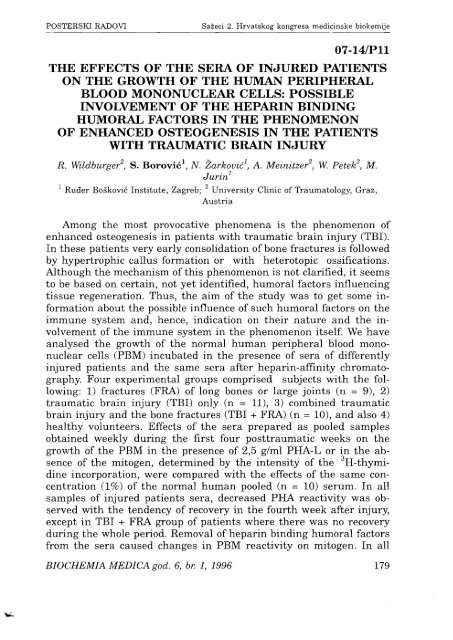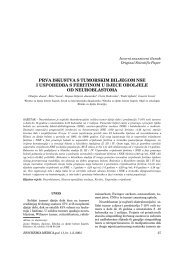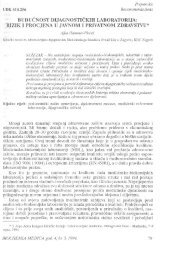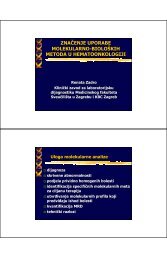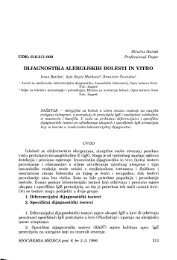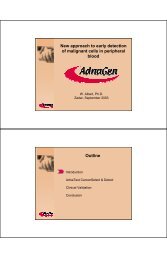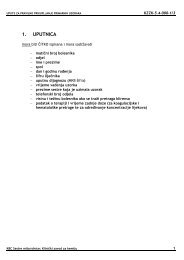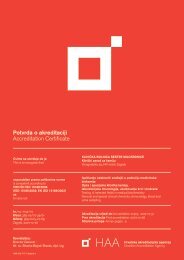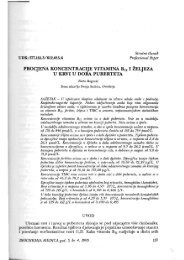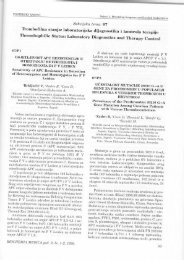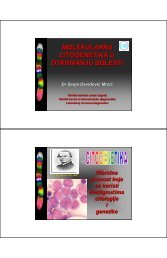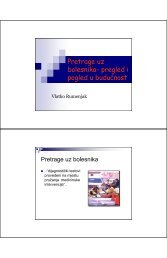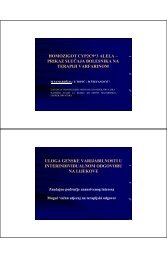Sažeci 2. Hrvatskog kongresa medicinske biokemije - Klinički zavod ...
Sažeci 2. Hrvatskog kongresa medicinske biokemije - Klinički zavod ...
Sažeci 2. Hrvatskog kongresa medicinske biokemije - Klinički zavod ...
Create successful ePaper yourself
Turn your PDF publications into a flip-book with our unique Google optimized e-Paper software.
07-14/P11<br />
THE EFFECTS OF THE SERA OF INJURED PATIENTS<br />
ON THE GROWTH OF THE HUMAN PERIPHERAL<br />
BLOOD MONONUCLEAR CELLS: POSSIBLE<br />
INVOLVEMENT OF THE HEPARIN BINDING<br />
HUMORAL FACTORS IN THE PHENOMENON<br />
OF ENHANCED OSTEOGENESIS IN THE PATIENTS<br />
WITH TRAUMATIC BRAIN INJURY<br />
R. midburger 2 , S. Borović 1 , N. Žarković 1 , A. Meinitzer 2 , W. Petek 2 , M.<br />
Jurin<br />
Ruđer Bošković Institute, Zagreb; University Clinic of Traumatologa Graz,<br />
Austria<br />
Among the most provocative phenomena is the phenomenon of<br />
enhanced osteogenesis in patients with traumatic brain injury (TBI).<br />
In these patients very early consolidation of bone fractures is followed<br />
by hypertrophic callus formation or with heterotopic ossifications.<br />
Although the mechanism of this phenomenon is not clarified, it seems<br />
to be based on certain, not yet identified, humoral factors influencing<br />
tissue regeneration. Thus, the aim of the study was to get some information<br />
about the possible influence of such humoral factors on the<br />
immune system and, hence, indication on their nature and the involvement<br />
of the immune system in the phenomenon itself. We have<br />
analysed the growth of the normal human peripheral blood mononuclear<br />
cells (PBM) incubated in the presence of sera of differently<br />
injured patients and the same sera after heparin-affinity chromatography.<br />
Four experimental groups comprised subjects with the following:<br />
1) fractures (FRA) of long bones or large joints (n = 9), 2)<br />
traumatic brain injury (TBI) only (n = 11), 3) combined traumatic<br />
brain injury and the bone fractures (TBI + FRA) (n = 10), and also 4)<br />
healthy volunteers. Effects of the sera prepared as pooled samples<br />
obtained weekly during the first four posttraumatic weeks on the<br />
growth of the PBM in the presence of 2,5 g/ml PHA-L or in the absence<br />
of the mitogen, determined by the intensity of the H-thymidine<br />
incorporation, were compared with the effects of the same concentration<br />
(1%) of the normal human pooled (n = 10) serum. In ali<br />
samples of injured patients sera, decreased PHA reactivity was observed<br />
with the tendency of recovery in the fourth week after injury<br />
except in TBI + FRA group of patients where there was no recovery<br />
during the whole period. Removal of heparin binding humoral factors<br />
from the sera caused changes in PBM reactivity on mitogen. In ali<br />
BIOCHEMIA MEDICA god. 6, br. 1, 1996 179


